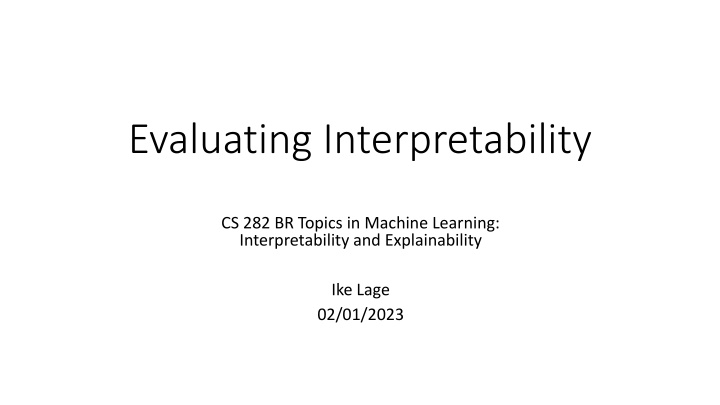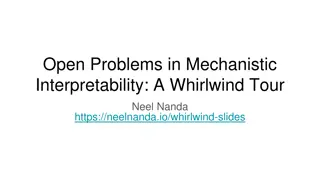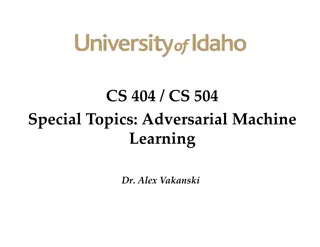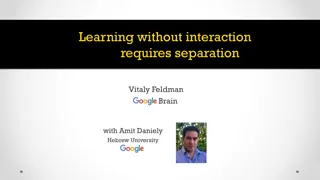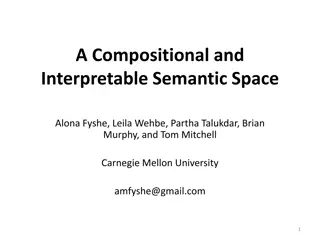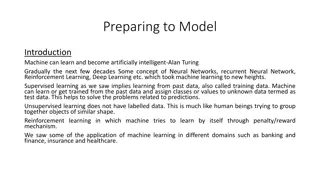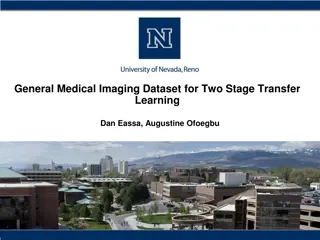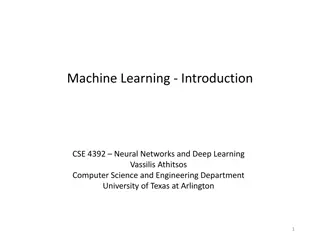Evaluating Interpretability in Machine Learning: Understanding Human-Simulatability Complexity
The paper discusses evaluating interpretability in Machine Learning by examining human-simulatability complexity and the relationship between decision set complexity and interpretability. It explores different factors affecting interpretability through user studies and highlights the significance of regularizing decision sets for building interpretable models.
Download Presentation

Please find below an Image/Link to download the presentation.
The content on the website is provided AS IS for your information and personal use only. It may not be sold, licensed, or shared on other websites without obtaining consent from the author.If you encounter any issues during the download, it is possible that the publisher has removed the file from their server.
You are allowed to download the files provided on this website for personal or commercial use, subject to the condition that they are used lawfully. All files are the property of their respective owners.
The content on the website is provided AS IS for your information and personal use only. It may not be sold, licensed, or shared on other websites without obtaining consent from the author.
E N D
Presentation Transcript
Evaluating Interpretability CS 282 BR Topics in Machine Learning: Interpretability and Explainability Ike Lage 02/01/2023
Overview Evaluating interpretability in the interpretable ML community: Interpretability depends on human experience of the model Disagreement about the best way to measure it These papers: Evaluating factors related to interpretability through user studies
Other Relevant Fields Human-Computer Interaction (HCI): Theories for how people interact with technology Psychology: Theories for how people process information Both have thought carefully about experimental design
Outline Research paper: Human Evaluation of Models Built for Interpretability by Lage et al. Research paper: Manipulating and Measuring Model Interpretability by Poursabzi-Sangdeh et al. Discussion
Contributions Research Questions: Which types of decision set complexity most affect human-simulatability? Is relationship between complexity and human-simulatability context dependent? Approach: Large scale, carefully controlled user studies
Decision Sets Logic-based models are often considered interpretable Many approaches for learning them from data
Regularizers There are many ways to regularize decision sets that make them less complex What kinds of complexity is it most urgent to regularize to learn interpretable models? Choose a regularizer for interpretability Optimize With regularizer Interpretable Model?
Types of Complexity Cognitive chunks Model size Variable repetitions
Types of Complexity Cognitive chunks Model size Variable repetitions What if we optimized the models with data?
Context: Domains Low Risk: Alien meal recommendation High Risk: Alien medical prescription
Context: Domains Low Risk: Alien meal recommendation High Risk: Alien medical prescription What if we used 2 different real domains?
Context: Tasks Simulation: What would the model recommend the alien? Verification: Is milk and guava a correct recommendation? Counterfactual: If patient were replaced with sleepy, would the correctness of the milk and guava recommendation change?
Context: Tasks Simulation: What would the model recommend the alien? Verification: Is milk and guava a correct recommendation? Counterfactual: If patient were replaced with sleepy, would the correctness of the milk and guava recommendation change? What if we used more realistic tasks?
Tradeoff between control and generalizability Tradeoff between the ability to tightly control the experiment and running it under realistic conditions (generalizability) This paper Tightly controlled Realistic
Procedure Experiment posted on Mturk Takes around 20 minutes Participants paid 3 USD Excluded participants who could not complete practice questions Total: 50-70 participants out of 150 3-6 practice questions 15-18 test questions Payment code Instructions
Statistical Analysis: Linear Model We use a linear model for each metric in each experiment Response time Accuracy Satisfaction
Statistical Analysis: Linear Model We use a linear model for each metric in each experiment Response time Accuracy Satisfaction Example Model Size, Response Time: Step 1: Fit linear regression to predict response time from number of lines and number of output terms Step 2: Interpret coefficients as effects of number of lines and number of output terms on response time
Stat. Analysis: Multiple Hypothesis Testing We use a Bonferroni correction Instead of p < 0.05, use p < (0.05 / # comparisons) Link: https://xkcd.com/882/
Results: Complexity increases response time Recipe Domain Longer response time Greater Complexity Greater complexity results in longer response time for all kinds of complexity
Results: Type of complexity matters Significant in one domain Model size Significant in all domains Cognitive chunks Significant in neither domain Variable repetitions Response time for: cognitive chunks > model size > repeated terms
Results: Consistency - Domains, Tasks, Metrics Model size For example: Similar effect sizes, both statistically significant Cognitive chunks Variable repetitions Results consistent across domains, tasks and the response time and subjective difficulty metrics
Results: Counterfactuals are hard Model size In all experiments, longer response time than simulation Cognitive chunks Variable repetitions The counterfactual task is much more challenging than simulation!
Discussion Consistent guidelines for interpretability Simplified tasks to measure interpretability Using Mturk workers as a proxy for domain experts
Motivation Interpretability as a latent property that can be manipulated or measured indirectly What are the factors through which it can be manipulated effectively? Bring HCI methods to interpretable ML since interpretability is defined by user experience
Contributions Research Questions: How well can people estimate what a model will predict? How much do people trust a model s predictions? How well can people detect when a model has made a sizable mistake? Approach: Large-scale, pre-registered user studies to answer these questions in the context of linear regression models
Comparison to Paper 1 Studies linear regression models instead of decision sets Measures people s ability to make their own predictions in addition to forward simulation Uses real-world housing dataset and models optimized with data
Ways to Manipulate Interpretability # of Features Transparency
Procedure Participants shown: Training: 10 apartments Testing: 12 apartments (this is the data they use) Participants paid 2.5 USD 750-1,250 participants per experiment Each Trial View model s true prediction Make own prediction Forward simulate model s prediction
Statistical Analysis: Participant Specific Effects A repeated measures experimental design Each participant makes many predictions Use a mixed-effects model to control for correlations between a participant s responses Assumes a random, participant-specific effect
Stat. Analysis: Multiple Hypothesis Testing Pre-registering hypotheses corresponds to deciding and publishing which analyses you will run before collecting data Reduces the probability that effects were discovered by chance For example: https://aspredicted.org/xy5s6.pdf
Design choices Randomized the order of the first 10 (normal) apartments and fixed the order of the last 2 (unusual) All participants are shown an identical set of apartments Each participant completed a single condition (between subjects design)
Design choices Randomized the order of the first 10 (normal) apartments and fixed the order of the last 2 (unusual) All participants are shown an identical set of apartments Each participant completed a single condition (between subjects design) Can introduce bias Increases variance Fix sources of randomness Randomize as much as possible
Results: Simulating small, transparent models Best simulation accuracy with small, transparent models
Results: No difference in trust or prediction None of the conditions are statistically different for trust or prediction error
Results: Clear models make mistakes worse Deviation Higher is better Participants deviate less from the bad prediction with clear models
Additional Experiments Scaled down prices to better reflect national average Same results
Additional Experiments Scaled down prices to better reflect national average Better trust metrics No significant different in trust between models
Additional Experiments Scaled down prices to better reflect national average Better trust metrics Attention check for unusual features People catch more errors
Discussion Highlighting weird inputs helps catch errors Having people predict before seeing the model helped catch errors Transparency actually makes people worse at catching errors
